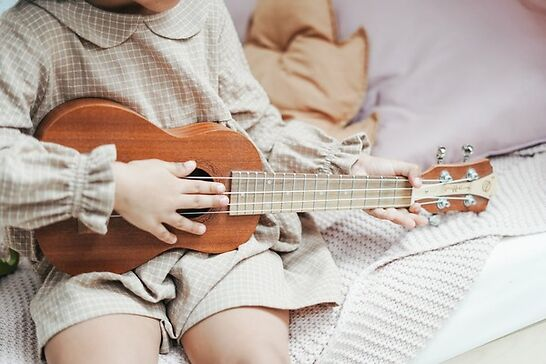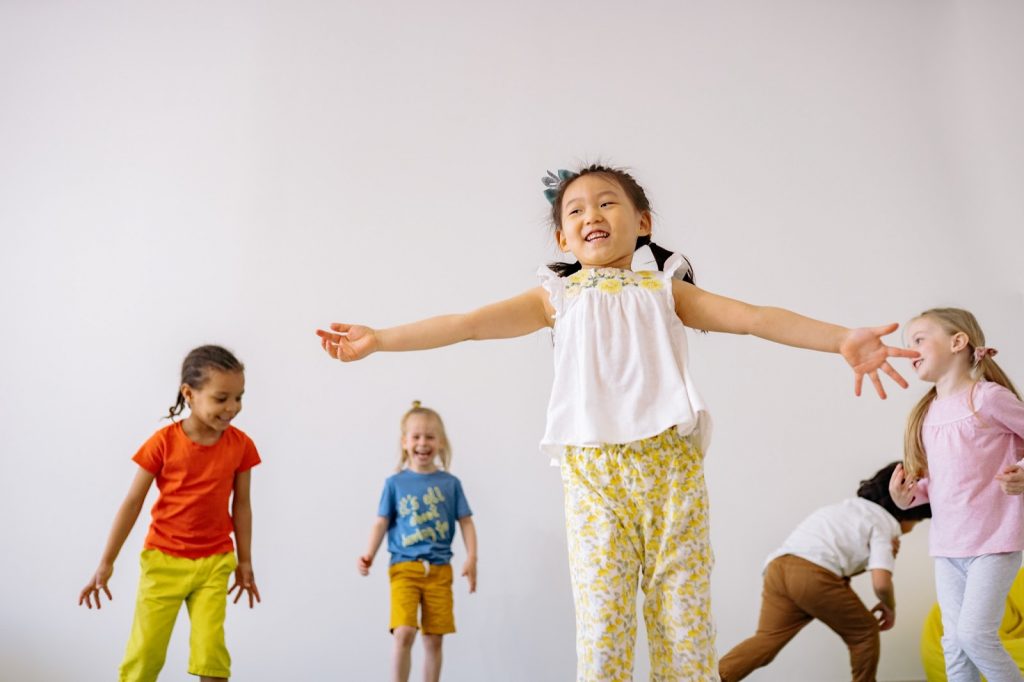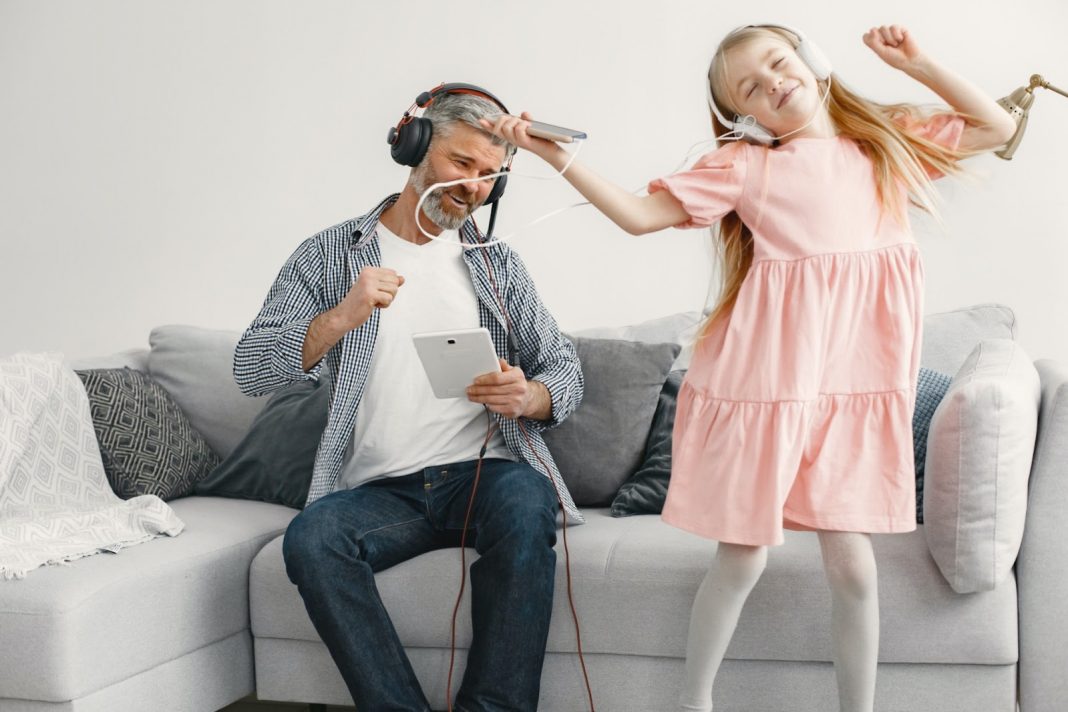When you picture a game that kids can have a good time with, what do you normally think of? Hopscotch? A game of hide-and-seek? Maybe puzzles and board games? What if you were told that a bit of music is all you need to make playtime more exciting and fun than it usually is? If you’re new to the idea of music games for kids, then you’ve come to the right place.
Math & ELA | PreK To Grade 5
Kids see fun.
You see real learning outcomes.
Watch your kids fall in love with math & reading through our scientifically designed curriculum.
Parents, try for free Teachers, use for free
It can be hard to find music games for kids online that are infectious enough to keep kids dancing and playing, but worry not! Here are fifteen games for kids that combine the auditory fun of music with the excitement of playtime.
Looking for more Math games and ELA games to educate and engage your kids? Here are more online educational games for kids to check out!
Benefits of Music in Early Childhood Education
Research shows that even unborn children can recognize the vibrations of sound! But that’s not all. They can even distinguish their mother’s voice from other individuals and differentiate music from noise! As a crucial part of our sensory experience, music offers an important avenue to support the growth and development of children, including their early childhood education.
This instant connection that children can form with sounds allows music to function as an educational tool in many ways! Children can learn how to pronounce words, say the alphabet, and count numbers with the help of music games! Children’s growing love for music can benefit them in several ways!
Related Reading: Best ABC Song for Kids That Will Make Them Dance & Enjoy
Benefits of Music Games
Here is how music games can benefit children!
- Music games usually involve some physical movement, which can help children develop their fine motor skills.
- Singing along to songs is a great way to improve literacy and communication skills.
- Music games are usually played in groups and help children to develop their social skills and self-confidence.
- Engaging with music improves memory, cognition, concentration, and spatial intelligence!
15 Amazing Music Games for Children

Whether you’re looking for music games for the classroom or something kids can enjoy at home, these games should fit the bill. But music isn’t all about fun. Combining music with playtime offers unique ways to develop kids’ social, intellectual, physical, and motor development and competencies.
1. Pass-the-Parcel
This classic needs no introduction and can be a great activity for a larger group of kids. If you’re looking for music games for the classroom, this one’s worth trying out.
What you need
All you need for this music game is a small parcel, a ball, or an object lightweight enough to be passed around easily. To make things even more exciting, the parcel may have a prize inside that the winner can keep once the game ends.
How to play
The rules are pretty straightforward! The competing participants have to sit around in a circle. They can sit on the floor or chairs. Once you start the music, the kids must keep passing the parcel around.
Stop the music at a random moment, and the kid holding the parcel at the moment the music stops must leave the game. Keep continuing this cycle until there’s only one player left.
What we like
This game can be incredibly exciting as it keeps kids on their toes, wondering when the music will stop. It is also a very flexible game that can be played differently.
You can also try having a parcel wrapped with dozens of layers, and every time the music stops, the participant with the parcel in their hand has to take off a layer. This cycle continues until the last layer is left. The participant who takes off the last layer wins.
Benefits of this game
There’s nothing quite like Pass-the-Parcel when it comes to fun music games for kids that promote their motor and social development by allowing them to connect with their peers through an exciting object passed around in a frenzy.
2. Musical Chairs
Music games for kids may be aplenty, but none bring the thrill of Musical Chairs. This game keeps kids on their toes (literally!) as they battle to stay in the game and claim the last chair left.
What you need
All you need for this game are chairs! If ten kids are participating, you would need nine chairs. If five kids are participating, you’d need four. The number of chairs you need will always be one less than the number of participating kids.
How to play
The chairs have to be arranged in a straight line. However, every subsequent chair must be facing the opposite direction. If the first chair faces north, the second one faces south, the third one faces north again, and the fourth one faces south. This is the pattern in which the chairs are to be arranged.
Once the chairs have been laid out, let the music play! The participating kids must move around the chairs as long as the music plays! When you randomly stop the music, the participants must sit on the chair closest to them.
Since the number of participants will always be more than the number of chairs, one kid won’t be able to secure a chair. This participant leaves the game, and the game continues. Every time the music is paused and a participant is eliminated, ensure one chair is removed from the line of chairs.
What we like
Musical Chairs should keep kids on their toes as they compete to stay in the game. It allows them to get physical and test their reflexes as they rush to secure a chair when the music stops.
Benefits of the game
Even though the game of Musical Chairs is straightforward, it offers kids a chance to develop their own strategies and approaches to claim the last chair. It can cultivate the development of their intellectual and motor skills.
3. Spin the Microphone

There are many music games for kids, but how about designing one yourself? Spin the Microphone is the perfect template for a game that lets kids decide how they’d like to play.
What you need
All you need to set up a game of spin the microphone is a microphone. A wireless one would work best. If it’s difficult to get a hold of a microphone, a bottle should work just fine.
How to play
Gather all the participants around in a circle and get comfortable. You could use chairs or sit on the floor. You can start by placing the microphone at the circle’s center and giving it a good spin. The microphone will slow down to a halt, with its top end facing one of the participants.
At this point, the person facing the microphone must sing a song or a nursery rhyme. If you’re playing with an active microphone, they can use it for their performance. Depending on the rules you’ve decided on, the person the microphone lands on could even read a short story.
What we like
Spin the Microphone is a template for a game that allows kids to decide how they want to spend their playtime. Spinning a microphone (or bottle!) brings an element of chance that makes it even more exciting.
Benefits of the game
Depending on the approach taken for this game, the benefits it offers may vary. Nonetheless, any participant who delivers a performance for their peers would invariably contribute to their emotional and social development. Singing a song, reciting a rhyme, or reading a book for your peers takes confidence.
4. Drawing Music
Music is an auditory experience that kids can enjoy, appreciate, and even study! Dancing and singing along to music are natural responses to engaging with music, but what if kids had to visualize and draw what they hear? How would they visualize sounds in pictures?
What you need
For this activity, you need a source of music that’s loud and clear enough for everyone to hear, along with some paper and art supplies. Kids can use crayons, colored pencils, and even paint, depending on how they visualize what they hear.
How to play
Once everyone has set up their desk space with the art supplies of their choice, you can let the music play. It would be great to have some variety in the music you play to see if you can identify an appreciable change in the kids’ art as a response to changes in the music genre. Do they use thin angular zig-zags to illustrate fast-paced music? Or curves and round shapes to depict bass?
What we like
This game allows kids to think about how they “see” music. Unlike other music games for kids that focus on physical movements with an element of competition, this is more about self-reflection, appreciation, and imagination.
Benefits of the game
Drawing music should promote kids’ intellectual development as they identify and assign visual cues and signs to an auditory medium. Engaging with crayons, colored pencils, and other art supplies is also a way for kids to develop their motor skills.
5. Karaoke

You can’t go wrong with karaoke, can you? It’s a great way to let everyone in on the fun. Whether your child has friends over for a playdate or you need an inclusive group activity to make class extra fun, karaoke won’t disappoint.
What you need
A karaoke machine would be the best fit, but you can always use any speaker system and hook it up to a microphone. Ensure you have the words to age-appropriate nursery rhymes and songs on a screen where everyone can see them.
How to play
Once you’ve figured out a karaoke system to work for you and have the words to popular nursery rhymes and songs playing along where everyone can see them, all that’s left to do is to get the party started. The kids can take turns among themselves, but if you want to make this more exciting, try spinning the microphone around to let it pick your next superstar.
What we like
Karaoke can be a great way to introduce kids to new songs and nursery rhymes. It offers an informal, fun-driven, collaborative approach to consuming memorable words and rhymes.
Benefits of the game
Memorizing the words to rhymes and songs can be daunting for kids, but having a microphone, music, and your friends to sing along with can make for a magical time. Kids should pick up new words and improve their memory retention, making karaoke a great way to sneak in intellectual development underneath all the fun.
6. Musical Limbo
Trying to walk under a beam, bent over backward, without falling down is fun enough. Add a little music to the mix, and it becomes a riot. Musical Limbo is a great way to get kids to engage in some physical exercise while testing their flexibility and cultivating their appreciation of music.
What you need
A meter-long ruler, a measuring tape, or a roll of string can work as a beam if you don’t have access to a regular one. Add a music source to the mix, and you’re ready.
How to play
All you need to get a game of musical limbo going is to put some music on, have two kids start by holding the bean, and line everyone up to take turns under the beam. The kids can bend over as much as they can to cross the beam without their bodies touching any part of it.
They can count their efforts as a win if they can make it across without coming in contact with the beam or their upper body and arms touching the floor. With some music playing in the background, you can rest assured that they’re in for an exciting time.
What we like
Musical Limbo is a no-frills approach to combining exercise with music. Regarding bonding exercises, there’s nothing quite like watching your peers fumble and tumble in a game of limbo.
Benefits of the game
Successfully passing under a beam requires kids to tighten their core and focus on their balance while bent backward and slowly inching forward on their toes. Combining these elements should provide quite a challenge while ensuring physical and motor development.
7. Make Your Own Drums
This game should work for you if you want something to please younger kids. Having kids find objects they can use as drums and drumsticks should inspire and test their creativity.
What you need
This game doesn’t require anything. What a kid uses for this game depends entirely on where they are and what they have at their disposal. A child at home should be able to find a pot or a bucket, along with some spoons and sticks, to work as their drums and drumsticks. On the other hand, a kid at school might end up using their lunchbox and some pencils.
How to play
The beauty of this game is that it doesn’t have any rules. As long as kids can find objects to work as drums and drumsticks, they should have a good time. Encouraging them to use different types of objects, such as drums can help them create a wider variety of sounds.
What we like
The beauty of this game is that it doesn’t have any rules. Kids can choose to have a drum-off or collaborate and play along to their favorite songs and rhymes. It has something for everyone.
Benefits of this game
This game should test the creativity of kids and nurture their intellectual development.
Related Reading: Children’s Songs When You Want to Dance With Your Kids
8. Musical Statue
Most children love any chance to dance to some music, but Musical Statue is here to change the formula. Also called freeze dance, this is another simple, no-frills approach to fun.
What you need
A source of loud music for everyone participating is all you need besides some great music to start the party.
How to play
The kids should start dancing as soon as the music starts playing. They can dance however they like as long as they keep going. When the music stops, they have to freeze immediately. Anyone who doesn’t freeze or someone who stumbles is eliminated from the next round. Keep going until you have a winner.
What we like
Musical Statue is great for younger children as it’s easy to follow without compromising on the fun.
Benefits of this game
Depending on the number of kids participating, Musical Statue can go on for quite a while and offers a great way to mix exercise with music.
9. The Clap Game
Learning to analyze music rhythms is a great precursor to music lessons and should excite children who are passionate about music. The Clap Game offers them the chance to do just that.
What you need
A source of music, access to some nursery rhymes and songs, along with some papers and markers are all you need to get started.
How to play
You can start by explaining the concept of whole and half notes to participating kids using paper, markers, and their corresponding clapping cues. Older kids may even be taught about quarter and eighth notes! Once the kids have understood the different notes and the claps they denote, draw a few time signatures and have them play them out.
What we like
This game works as a great precursor to music classes and works well, no matter how many kids participate.
Benefits of this game
This game has a learning element, as it challenges kids to associate visual cues with auditory sounds while reproducing these sounds as claps. The Clap Game perfectly blends visual, auditory, and intellectual development.
10. Guess the Instrument
Perfect for younger kids, Guess the Instrument is about letting kids guess the instrument they’re hearing. It’s a great way to introduce kids to different kinds of instruments and recognize the kind of sound these instruments produce. Older kids can even be introduced to the system of instrument classification.
What you need
This music playlist offers a sound collection of songs from different genres with different leading instruments that you can use for this game. You can also create your own playlist.
How to play
Once the participating kids have been introduced to and have learned to recognize the sounds produced by different musical instruments, you have to play short segments of different songs with different instruments in use and ask them to guess the instrument they hear.
What we like
This is a great way to help kids recognize the difference in the sounds produced by different instruments. You can take this further with musically experienced kids by teaching them how to differentiate the sounds of instruments from the same family.
Benefits of this game
Guess the Instrument offers a simple but effective way to ensure the auditory development of younger kids, along with students who may be new to music.
11. Musical Clothes
If you’re looking for a different take on musical chairs, Musical Clothes may be just the game for you! Instead of eliminating kids as they fail to secure a chair, this one allows everyone to keep playing until the end and can be a great alternative when you have more kids to engage.
What you need
All you need for this game are some chairs and a bagful of whacky clothing items ranging from pompoms, colorful ties, unusual hats, party props, capes, and anything else you can find.
How to play
Arrange an equal number of chairs as players in a circle face the circle’s center. Have all the kids take a seat and hit the music! Once the music starts, the bagful of wacky clothes has to be passed around until you pause the music. When the music pauses, the participant holding the bag has to take out one item from the bag and put it on! Repeat until the bag is empty! The kid with the wackiest style wins.
What we like
With no scope of elimination, Musical Clothes is more about fun than competition. It lets everyone in on the fun until the very end!
Benefits of this game
A bag of whacky clothing is a great way to let kids get creative about what they’re willing to put on and develop their confidence. If social and emotional development are what you’re targeting, look no further.
12. Feel the Music
A different take on having kids draw the music they hear, Feel the Music is all about encouraging kids to visualize different sounds with body movements.
What you need
A collection of varied songs and a music source loud enough for everyone to hear is all you need to get started.
How to play
You can start by playing something more mellow and calm before abruptly switching to something chaotic and loud! This should help kids better understand variations in music to expect and, accordingly, decide how they want to represent these varying sounds.
What we like
Feel the Music is a great way to combine music with some exercise.
Benefits of this game
This dancing game encourages kids to think on their feet by adapting to different kinds of music.
13. Animal Dance
When getting kids to put on their thinking hats, no game does it quite like Animal Dance. They must interpret how an animal might dance and mix up their dance with appropriate animal sounds and moves.
What you need
This game does not require anything; you can dictate the animal’s name to which a participant must interpret and dance.
How to play
With this game, kids can either take turns dancing to the name of the same animal, or you can switch up the animal after every kid’s performance. If you want to make this more exciting, you can even prepare a small box with folded pictures of animals that kids have to draw one by one before dancing to the animal they get.
Once everyone has had a go, you can fold the pictures, put them back in the box, and shake it up before the next round.
What we like
This game encourages children to contemplate the qualities of animals, such as the sounds they make and the way they move, among other attributes, which they may not necessarily think about when simply looking at their pictures.
Benefits of this game
Animal dance offers a fun way to inspire creativity and nurture young kids’ curiosity about the animal kingdom.
14. Group Tune
A group tune is the way to go if you’re looking for a musical time heavy on collaboration. It offers a way for kids to create interesting music with little effort.
What you need
Depending on whether you’re at home or school, pots, pans, eating utensils, desks, chairs, stationery, and anything else you can think of that can be safely used to produce music should work just fine.
How to play
Have kids form groups of two or more. Have one kid from each group use their instruments to produce and sustain a melody. Once they’ve got a hold of their melody, have another person join them with their instrument and melody. And then the next person, and so on.
What we like
This straightforward and no-frills approach to collaboration allows kids to experiment with sounds and create music they enjoy.
Benefits of this game
This collaborative game for kids should inspire their curiosity for music while contributing to their social and auditory development.
15. Stomping
Stomping is a great alternative to clapping when engaging with a song or rhyme. Kids may prefer being seated for fast-paced songs, while they should be fine standing for slower ones.
What you need
A music source loud enough for everyone to hear is all you need.
How to play
Have the kids follow their stomps to a song or rhyme so they understand how to time their stomps and how long they need to be. A few songs to get started should be enough for them to understand the rhythm of their stomps and how to appropriately match them to a new song.
What we like
Stomping is a great alternative to clapping, but it doesn’t have to be. You can even have kids combine the two and mix things up.
Benefits of this game
Stomping to the beats of music is harder than it looks and should make great exercise, whether kids go about it standing up or sitting at desks.

Related Reading: Best Fun Party Games for Kids to Have an Amazing Time
Get the Party Started!
Combining music with playtime offers a great alternative to the routine, whether a game of musical chairs or some playful karaoke. If you’re looking to make a play just a bit more exciting, you can count on the power of music to get kids up on their feet and moving along. Music games free for kids aren’t easy to find, and we hope your search ends with these fantastic fifteen.
Frequently Asked Questions (FAQs)
At what age can kids start playing music games?
It’s never too early to start music games! Your child should start enjoying music games with their peers as early as prekindergarten, but you can always give them a go even earlier if you’d like!
Are there any precautions that should be taken before engaging in music games?
Definitely! Whenever children are engaged in a music game that involves sounds, ensure that the source of the sounds, whether it’s a television, music player, or speakers, is set at a sound volume level that isn’t too loud! Toddlers, infants, and young children can experience hearing loss with continuous exposure to loud sounds.
























